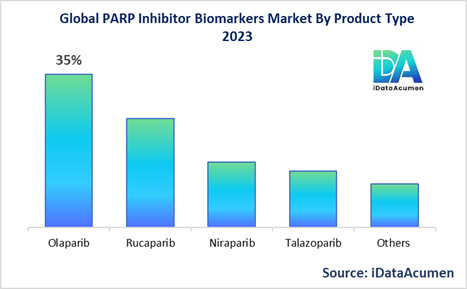PARP Inhibitor Biomarkers Market Expected to Achieve US$ 10.0 Bn by 2031 with a growing CAGR of 17.2% during the forecast period 2024-2031. The PARP Inhibitor Biomarkers Market falls under the pharmaceuticals and biotechnology industry. PARP inhibitors are a class of targeted cancer therapies that inhibit the enzyme poly (ADP-ribose) polymerase (PARP), which is involved in DNA repair mechanisms. These inhibitors are particularly effective in treating cancers with deficiencies in DNA repair pathways, such as BRCA-mutated cancers.
The rising prevalence of cancer, coupled with the increasing adoption of biomarker testing and personalized medicine approaches, is driving the growth of the PARP Inhibitor Biomarkers Market. Additionally, the expanding indications for PARP inhibitors, including approvals for various cancer types like ovarian, breast, and prostate cancers, are further fueling market growth. Regulatory bodies have been supportive of these targeted therapies, recognizing their potential for improved efficacy and reduced side effects compared to traditional chemotherapies.
The PARP Inhibitor Biomarkers Market is expected to experience significant growth, driven by favorable market dynamics and emerging opportunities. The market's growth is propelled by ongoing research and development efforts, including the exploration of novel PARP inhibitors, combination therapies, and targeted drug delivery systems. Furthermore, advancements in biomarker testing and companion diagnostics are facilitating the identification of patients who are most likely to benefit from these targeted therapies, enhancing the market's potential.
The PARP Inhibitor Biomarkers Market falls under the pharmaceuticals and biotechnology industry. PARP inhibitors are a class of drugs used to treat cancers, particularly those with deficiencies in DNA repair mechanisms like BRCA mutations. These inhibitors target the enzyme poly (ADP-ribose) polymerase (PARP), which plays a crucial role in DNA repair.

Key Report Insights:
- Market Driver: Increasing prevalence of cancer and growing awareness about PARP inhibitors as a targeted therapy. According to the World Health Organization, cancer is the second leading cause of death globally, with an estimated 9.6 million deaths in 2018.
- Companies are actively investing in research and development of PARP inhibitors. For example, AstraZeneca's Lynparza (olaparib) and Clovis Oncology's Rubraca (rucaparib) are approved PARP inhibitors for ovarian and breast cancers with BRCA mutations.
- Advancements in biomarker testing and companion diagnostics have facilitated the identification of patients who can benefit from PARP inhibitor therapy, driving market growth.
- The emergence of novel drug delivery systems and combination therapies involving PARP inhibitors is expected to expand the market further.
Drivers:
- Increasing Prevalence of Cancer: The rising global incidence of various cancers, including ovarian, breast, and prostate cancers, is driving the demand for effective and targeted therapies like PARP inhibitors. According to the World Health Organization, cancer was responsible for nearly 10 million deaths in 2020.
- Expansion of Approved Indications: Initially approved for ovarian cancer, PARP inhibitors have now received approval for various other cancer types, including breast, prostate, and pancreatic cancers. As more indications are added, the market for PARP inhibitors is expected to grow substantially.
- Favorable Regulatory Environment: Regulatory bodies, such as the FDA and EMA, have been supportive of the development and approval of PARP inhibitors, recognizing their potential as targeted therapies with fewer side effects compared to traditional chemotherapy.
Trends:
- Increasing Adoption of Biomarker-Driven Precision Medicine.
- Development of Companion Diagnostics for Patient Selection.
Market Opportunity:
Exploring the potential of PARP inhibitors in non-oncology therapeutic areas.
Key Report Insights:
- North America is expected to be the largest market for the PARP Inhibitor Biomarkers Market, accounting for over 38.2% of the market share. Prominent companies with a strong presence in the region include AstraZeneca, GlaxoSmithKline, and Clovis Oncology. The market growth in North America is driven by factors such as well-established healthcare infrastructure, favorable reimbursement policies, and significant investment in cancer research and development.
- Europe is expected to be the second-largest market for the PARP Inhibitor Biomarkers Market, accounting for over 27.9% of the market share. Major companies operating in the region include AstraZeneca, GlaxoSmithKline, and Pfizer. The market growth in Europe is supported by the increasing adoption of personalized medicine approaches, advancements in biomarker testing, and the availability of advanced healthcare facilities.
- Prominent companies present in the PARP Inhibitor Biomarkers Market include AstraZeneca, GlaxoSmithKline, Clovis Oncology, Pfizer, Merck & Co., Abbvie, and Eisai Co.
Market Segmentation:
- By Product Type
- Olaparib
- Rucaparib
- Niraparib
- Talazoparib
- Others (Veliparib, Pamiparib, etc.)
- By Cancer Type
- Ovarian Cancer
- Breast Cancer
- Prostate Cancer
- Lung Cancer
- Pancreatic Cancer
- Others (Colorectal, Gastric, etc.)
- By Biomarker Type
- BRCA Mutations
- HRR Gene Mutations
- PARP Expression
- Others (SLFN11, ETS, etc.)
- By Therapy
- Monotherapy
- Combination Therapy
- By End User
- Hospitals
- Specialty Clinics
- Cancer Research Centers
- Others (Diagnostic Laboratories, etc.)
- By Distribution Channel
- Hospital Pharmacies
- Retail Pharmacies
- Online Pharmacies
- Others (Drug Stores, etc.)
- By Region
- North America
- Europe
- Asia-Pacific
- Latin America
- Middle East & Africa
Definition:
“The PARP Inhibitor Biomarkers Market refers to the industry focused on developing and commercializing a class of targeted cancer therapies known as PARP inhibitors. These drugs target the enzyme poly (ADP-ribose) polymerase (PARP), which plays a crucial role in DNA repair mechanisms. PARP inhibitors are particularly effective in treating cancers with deficiencies in DNA repair pathways, such as those caused by BRCA gene mutations, making them a novel approach to personalized cancer treatment with potentially fewer side effects compared to traditional chemotherapy.”